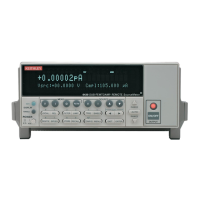IEEE-488 Bus Overview D-9
Address commands
Addressed commands include two primary command groups and a secondary address
group. ATN is true when these commands are asserted. The commands include:
LAG (Listen Address Group) — These listen commands are derived from an instrument’s
primary address and are used to address devices to listen. The actual command byte is obtained
by ORing the primary address with #H20.
TAG (Talk Address Group) — The talk commands are derived from the primary address
by ORing the address with #H40. Talk commands are used to address devices to talk.
SCG (Secondary Command Group) — Commands in this group provide additional
addressing capabilities. Many devices (including the SourceMeter) do not use these commands.
Unaddress commands
The two unaddress commands are used by the controller to remove any talkers or listeners
from the bus. ATN is true when these commands are asserted.
UNL (Unlisten) — Listeners are placed in the listener idle state by the UNL command.
UNT (Untalk) — Any previously commanded talkers will be placed in the talker idle state
by the UNT command.
Common commands
Common commands are commands that are common to all devices on the bus. These com-
mands are designated and defined by the IEEE-488.2 standard.
Generally, these commands are sent as one or more ASCII characters that tell the device to
perform a common operation, such as reset. The IEEE-488 bus treats these commands as data
in that ATN is false when the commands are transmitted.
SCPI commands
SCPI commands are commands that are particular to each device on the bus. These com-
mands are designated by the instrument manufacturer, and are based on the instrument model
defined by the Standard Commands for Programmable Instruments (SCPI) Consortium’s SCPI
standard.
Generally, these commands are sent as one or more ASCII characters that tell the device to
perform a particular operation, such as setting a range or closing a relay. The IEEE-488 bus
treats these commands as data in that ATN is false when the commands are transmitted.

